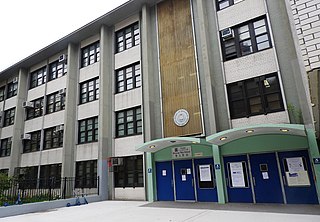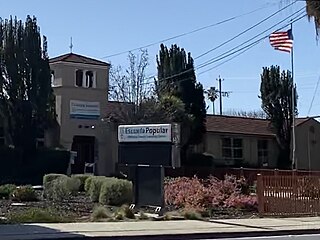In bilingual education, students are taught in two languages. It is distinct from learning a second language as a subject because both languages are used for instruction in different content areas like math, science, and history. The time spent in each language depends on the model. For example, some models focus on providing education in both languages throughout a student's entire education while others gradually transition to education in only one language. The ultimate goal of bilingual education is fluency and literacy in both languages through a variety of strategies such as translanguaging and recasting.

English as a second or foreign language is the use of English by speakers with different native languages. Language education for people learning English may be known as English as a foreign language (EFL), English as a second language (ESL), English for speakers of other languages (ESOL), English as an additional language (EAL), or English as a New Language (ENL).

PS 184M Shuang Wen School, a public school in New York City also known as PS 184, is a Dual Language elementary and middle school located in Lower Manhattan. The school teaches students from Pre-Kindergarten to 8th grade. It is a part of the New York City Department of Education and located in Manhattan District 1 which includes the Lower East Side and East Village. A major $1.7 million renovation of the school playground and soccer field was completed in 2019 by the Trust for Public Land and DEP. In the elementary school, the school teaches in Traditional Chinese and utilizes the zhuyin phonetic system popular in Taiwan. During the typical school day, one day is taught in English and other day is in Mandarin. As a Dual Language school, classes in both languages are a mandatory part of the curriculum.

Language immersion, or simply immersion, is a technique used in bilingual language education in which two languages are used for instruction in a variety of topics, including math, science, or social studies. The languages used for instruction are referred to as the L1 and the L2 for each student, with L1 being the student's native language and L2 being the second language to be acquired through immersion programs and techniques. There are different types of language immersion that depend on the age of the students, the classtime spent in L2, the subjects that are taught, and the level of participation by the speakers of L1.

The Elementary and Secondary Education Act (ESEA) was passed by the 89th United States Congress and signed into law by President Lyndon B. Johnson on April 11, 1965. Part of Johnson's "War on Poverty", the act has been one of the most far-reaching pieces of federal legislation affecting education ever passed by the United States Congress, and was further emphasized and reinvented by its modern, revised No Child Left Behind Act.

Arizona Proposition 203, also known as English for the Children, is a ballot initiative that was passed by 63% of Arizona voters on November 7, 2000. It limited the type of instruction available to English language learner (ELL) students. Before Proposition 203, schools were free in terms of ELL instruction to use bilingual or immersion methods. According to a cover letter from the Arizona Department of Education Superintendent of Public Instruction Lisa Graham Keegan to the Arizona Legislature, it was impossible to make a correct analysis regarding how many students were learning through English as a second language programs, as opposed to bilingual education. The school districts had submitted "conflicting information," and 40% had not submitted any data, in spite of three deadline extensions.

The Bilingual Education Act (BEA), also known as the Title VII of the Elementary and Secondary Education Amendments of 1967, was the first United States federal legislation that recognized the needs of limited English speaking ability (LESA) students. The BEA was introduced in 1967 by Texas senator Ralph Yarborough and was both approved by the 90th United States Congress and signed by President Lyndon B. Johnson on January 2, 1968. While some states, such as California and Texas, and numerous local school districts around the country already had policies and programs designed to meet the special educational needs of elementary and secondary school students not fluent in the English language, this act signaled that the federal government now also recognized the need for and value of bilingual education programs in U.S. public education. In 1969 there was a 50% drop out rate among Mexican American students who struggled to keep up with their English-speaking peers in school; Representative Tony Abril argued that the Bilingual Education Act would reduce this number. Passed on the heels of the Civil Rights Movement, its purpose was to provide school districts with federal funds, in the form of competitive grants, to establish innovative educational programs for students with limited English speaking ability.
English-Language Learner is a term used in some English-speaking countries such as the United States and Canada to describe a person who is learning the English language and has a native language that is not English. Some educational advocates, especially in the United States, classify these students as non-native English speakers or emergent bilinguals. Various other terms are also used to refer to students who are not proficient in English, such as English as a Second Language (ESL), English as an Additional Language (EAL), limited English proficient (LEP), Culturally and Linguistically Diverse (CLD), non-native English speaker, bilingual students, heritage language, emergent bilingual, and language-minority students. The legal term that is used in federal legislation is 'limited English proficient'. The instruction and assessment of students, their cultural background, and the attitudes of classroom teachers towards ELLs have all been found to be factors in the achievement of these students. Several methods have been suggested to effectively teach ELLs, including integrating their home cultures into the classroom, involving them in language-appropriate content-area instruction early on, and integrating literature into their learning programs.
The San Diego State University College of Education is home of SDSU's teacher education and training programs. It offers undergraduate programs, teaching credentials for degree holders, master's degrees and both the Ed.D and Ph.D doctoral degrees.
Limited English proficiency (LEP) is a term used in the United States that refers to a person who is not fluent in the English language, often because it is not their native language. Both LEP and English-language learner (ELL) are terms used by the Office for Civil Rights, a sub-agency of the U.S. Department of Education.
Dual language is a form of education in which students are taught literacy and content in two languages. Most dual language programs in the United States teach in English and Spanish, but programs increasingly use a partner language other than Spanish, such as Arabic, Chinese, French, Hawaiian, Japanese, or Korean. Dual language programs use the partner language for at least half of the instructional day in the elementary years.
The English Language Acquisition, Language Enhancement, and Academic Achievement Act - formerly known as the Bilingual Education Act - is a federal grant program described in Title III Part A of the federal Elementary and Secondary Education Act (ESEA), which was reauthorized as the No Child Left Behind Act in 2002 and again as the Every Student Succeeds Act in 2015. This section is specifically targeted to benefit Limited English Proficient (LEP) children and immigrant youth. The statute states that LEP students must not only attain English proficiency but simultaneously meet the same academic standards as their English-speaking peers in all content areas. Federal funding is provided to assist State Education Agencies (SEAs) and Local Education Agencies (LEAs) in meeting these requirements. In 2011, ESEA Title III awards were granted to 56 SEAs and the average award given to an individual SEA was $12,158,046.
Velázquez Press is the publisher of Velázquez Spanish and English Dictionary.
Structured English Immersion (SEI) is a total immersion bilingual education technique for rapidly teaching English to English Language Learners. The term was coined by Keith Baker and Adriana de Kanter in a 1983 recommendation to schools to make use of Canada's successful French immersion programs. The Canadian model was developed to encourage bilingualism through immersing Anglophones in the minority language and replaced many English-only laws in various Canadian provinces before the 1960s, while in the United States the same approach was advocated to force minority speakers to adopt English.
The Rhode Island Department of Education (RIDE) is a state agency in Rhode Island that oversees the elementary and secondary education system from pre-Kindergarten through twelfth grade. It is headquartered in Providence. RIDE works closely with the Rhode Island Office of the Postsecondary Commissioner (RIOPC), the agency charged with overseeing higher education. Together, RIDE and RIOPC aim to provide an aligned, cohesive, and comprehensive education for all students.

Centennial High School is a public high school in Compton, California, operating as part of the Compton Unified School District.
Heritage language learning, or heritage language acquisition, is the act of learning a heritage language from an ethnolinguistic group that traditionally speaks the language, or from those whose family historically spoke the language. According to a commonly accepted definition by Valdés, heritage languages are generally minority languages in society and are typically learned at home during childhood. When a heritage language learner grows up in an environment with a dominant language that is different from their heritage language, the learner appears to be more competent in the dominant language and often feels more comfortable speaking in that language. "Heritage language" may also be referred to as "community language", "home language", and "ancestral language".
English immersion programs have students to be fully immersed in the American culture, which starts by learning its language — English. A number of those who enroll into English immersion programs are immigrant children. Due to the fact that more ambitious choices are made by immigrant students than nonimmigrant students regarding academic choices, secondary effects, such as these English immersion programs, create positive outcomes. Immigrant children is defined as children who have at least one foreign born parent. Some immigrant students show proficiency in English after being in the program for only 2–3 years while others take longer. There are not many other resources provided by schools that students can go to if they want to learn or improve their English. As a result, it can possibly affect immigrant students' proficiency in English.

Spanish bilingual education in California is the incorporation of the Spanish and English language to teach various subjects in primary education. Proposition 227 affected Spanish bilingual programs negatively by mandating that instruction be conducted "overwhelmingly in English." Although there was no direct statement in this proposition prohibiting the use of Spanish for instruction, many teachers and districts stopped teaching in the Spanish language because they were pressured to focus on English-only curriculum. However, there continue to be dual language bilingual programs in the state.







